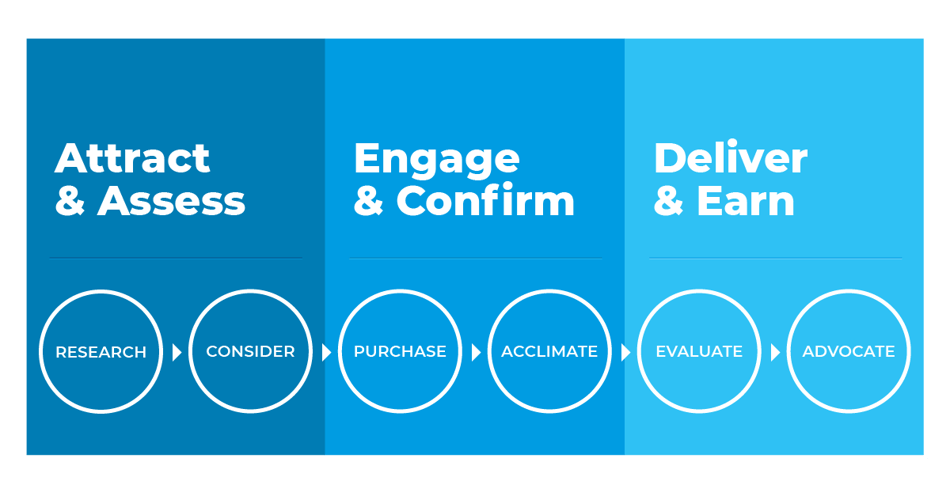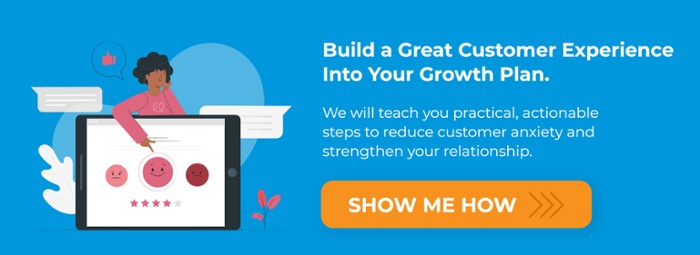
How to Create a Health Tech Content Strategy
Patrick Dodge
Founder
Is your health technology company publishing content online, but you aren’t sure what it’s doing to generate business?
If you aren’t sure how your website is producing ROI then a few tweaks might be in order.
Skipping small, yet important steps - like defining your ideal buyer, gathering insights about how they make decisions, and documenting how your content will address their needs - makes it much harder to evaluate the effectiveness of your content.
There’s simply too much competition in the health tech industry today to base your strategy on guesswork. But before diving in, it’s important to clarify why your company is creating content in the first place.
What is a Content Strategy?
A content strategy is the business process of organizing and publishing high value information that helps your audience learn and encourages them to take a desired action.
Every company wants their material to inspire people to buy their solution, but most of them make at least one of the following mistakes that keep it from working:
- They haven’t gotten real insights about how their buyers make decisions.
- Their content does not meet people at the intersection where they are looking for answers.
- They try to sell people with their content, rather than help them.
If your brand is struggling with these issues – don’t worry. This post will help you put the wheels back on.
Components of a Successful Content Strategy
It’s important to understand the following terms to build a strong foundation with your content:
1. Ideal Buyer Profile – Rather than marketing to every potential buyer out there, it’s far better to target your content at hospitals, clinics, or other organizations that make the best fit for your solutions.
Run a report and look at the customers who spend the most, have the highest satisfaction scores, and offer the longest lifetime customer value (LCV). What attributes do these accounts share that will help you create an ideal buyer profile? Here are six questions to consider:
- Which sizes make a better fit?
- How will you define size? Employees, annual revenue, or another value?
- Are healthcare providers with certain specializations better for your solution?
- Do geographic locations play a role?
- What other attributes make the buyer ideal or not ideal?
Your content strategy will be 10x more effective if it’s focused on potential buyers that exist within your ideal buyer segment.
2. Buyer Personas – With your ideal buyer profile completed, you want to explore and document how the buying committee within those organizations evaluate and purchase solutions like yours. This is called a buyer persona profile.
A word of caution here. You'll want to avoid building persona profiles out of demographic information gathered from a few conversations with customers and/or your sales team. This approach does nothing to help you understand what motivates people to buy your product and when.
If you want to truly understand the buying decision process we recommend conducting unscripted interviews with people who have evaluated a solution like yours in the last 6 to 12 months. The best insights come from buyers your company pitched and lost, or ones that have never heard of your brand at all.
Qualitative research recruiting agencies can help you find people to interview, or you can use resources like User Interviews if you want to do it yourself.
4. Customer Journey – This is the process that outlines the entire relationship your brand has with a customer, which we’ve broken up into three stages.

In the Attract & Assess stage, prospects are investigating a challenge and considering possible solutions.
When they reach the Engage & Confirm stage, they purchase your solution and try to acclimate to the delivery process.
Throughout the Deliver & Earn stage, the customer evaluates the relationship as your team delivers the promised result.
Brands that deliver great results and provide an excellent customer experience are most likely to turn their customers into advocates, earning word-of-mouth referrals (the best marketing there is).
5. Set Your Objectives – Your content strategy must be tied to SMART goals the marketing team will be held accountable for. Otherwise, you will never know whether or not it is successful.
Start by figuring out the revenue gap that exists between the growth you want and your current state of closed business (10-20% growth is usually achievable). You can then back out the number of customers, opportunities, and sales qualified leads you will need to reach that objective.
Your content strategy will be instrumental for attracting the right personas from your ideal buyer profile to your website, where you can convert them into leads using valuable content offers.
Use our Goal Setting Template to easily find your gap and confirm the milestones needed to fill it.
Planning a Content Strategy
At this stage you should have SMART goals established and a roadmap that shows the conversion metrics needed to achieve them.
You should also have an ideal buyer profile that defines a segment of your customer base that’s most profitable to your business, along with clear insights into how the personas within healthcare organizations make buying decisions. Now’s it’s time to start mapping out your content for the customer journey.
The success of your strategy will depend on your team’s ability to create remarkable content that delivers a ton of value to your personas. Keeping your content aligned with the buyer’s needs at each stage of the journey is critical for success.
Here is one golden rule for maximizing your impact: Fall in love with your customer’s challenges, not your solution.
When you stay focused on their challenges, you can identify changes on the horizon that reveal fresh opportunities to help. You can’t do that if you are on publishing content about how great your solution is.
Immerse your content in the buyer’s problems, and use it to educate them about how to overcome these challenges. You will get a far greater response than writing about your company or its products. I guarantee it.
"Fall in love with your customer’s challenges, not your solution."
Content + Context
The key to successful inbound marketing is creating remarkable content in the context of the buyer.
A serious investment in any health tech solution requires research, and now that you know what your buyers care about you can create content that fits their context at each stage (including after the sale).
Think of your business as a Sherpa for your ideal buyer, guiding them in their research and qualifying them as a good-fit prospect along the way.
A marketing automation platform will help you track how your contacts are engaging with your content, giving your team the insights they need to optimize your strategy, understand the context of the buyer, and provide the experience people are looking for.
Building a Long-Term Content Plan
A long-term plan is critical because it facilitates consistency, organization, and accountability.
Updating the blog or posting videos is not something you can put on hold when you are busy. Your content is your savings account. Each deposit you make may not seem like much, but the value aggregates as your cache grows.
Let’s revisit the customer journey for a moment. During the Attract & Assess stage, we are trying to intercept buyers as they enter the market, providing information to help them understand their challenge on a deeper level, and giving them tips to solve it.
Your persona profile should give you insights that explain how your buyers make decisions, starting with the Priority Initiative. This insight tells us what pain(s) cause your persona to look for a solution and why they choose to look when they do.
Make a list of content ideas that will help them at this early research phase, followed by ideas that will help them compare possible solutions as they shift into the assessing their options.
Be sure to brainstorm ideas for all stages of the customer journey – not just Attract & Assess. Many brands focus only on acquiring new customers, forgetting the fact that profits grow exponentially when you offer a great experience to existing customers!
Your content strategy should include assets that improve your client on-boarding and acclimation stages of the relationship, as well as enhancements you can offer to customers who have done business with you for months or years. The impact you could make on your growth will far outweigh the costs!
Once your content ideas are plotted along the customer journey, you might be feeling a little overwhelmed by the work ahead.
Here is the good news: Almost every company has content stored in random places around the office. I’m going to show you how to do a quick audit and find those hidden gems that will give your content strategy a running start!
Company Content & Event Audits
There are two types of internal audits that will help you find content you can put to good use.
Content audit – This research will help you gather all assets at your disposal, identify places where gaps exist, and uncover opportunities.
Start by looking through shared drives where marketing and sales collateral is stored, then talk to your colleagues and see if they can point you in a few directions. Start with employees who have been around the longest, then talk to sales, marketing, and service teams and see what they’ve got.
Don’t forget to check emails to customers as well! It’s amazing how much helpful information companies send to prospects and clients and then never use again. Ask everyone to go through their sent folder and copy/paste any information that will help jumpstart your strategy.
Organize everything you find on a spreadsheet, and tag it by content type, buyer’s journey stage, and any other data that will help you integrate the asset into your content calendar.
Event audit – An event audit helps you identify upcoming projects or priorities that involve content creation. Similar to the content audit above, you will want to create a worksheet that sorts upcoming priorities by month, provides an overview of the theme, and any prospective blog post topics that would tie the event to your content strategy.
You can now figure out which assets can be polished and reused, and how planned content for upcoming events will support your overall strategy. Start prioritizing content you need but don’t yet have, and organize them in your content calendar.
Start Creating
As you start work on your content strategy, you will want to offer open access to valuable material while also looking for opportunities to get people to convert, or opt-in.
This is a judgment call every brand must make, but my advice is to be generous. The more valuable content you share without requiring a form fill, the more people will access and consume what you have to offer.
You will also want to consult with an SEO and conversion optimization expert to ensure the topics you focus on have the best chance to getting found on the channels where your healthcare providers look for information.
The steps above may sound like a lot to take on, but when you spread the process across four to six weeks you will find it much more manageable. In the end you will have a solid foundation to your sales and marketing efforts, based on real insight into what customers are looking for.
Leave the guesswork to your competitors.
Mar 6, 2020 1:38:09 PM
